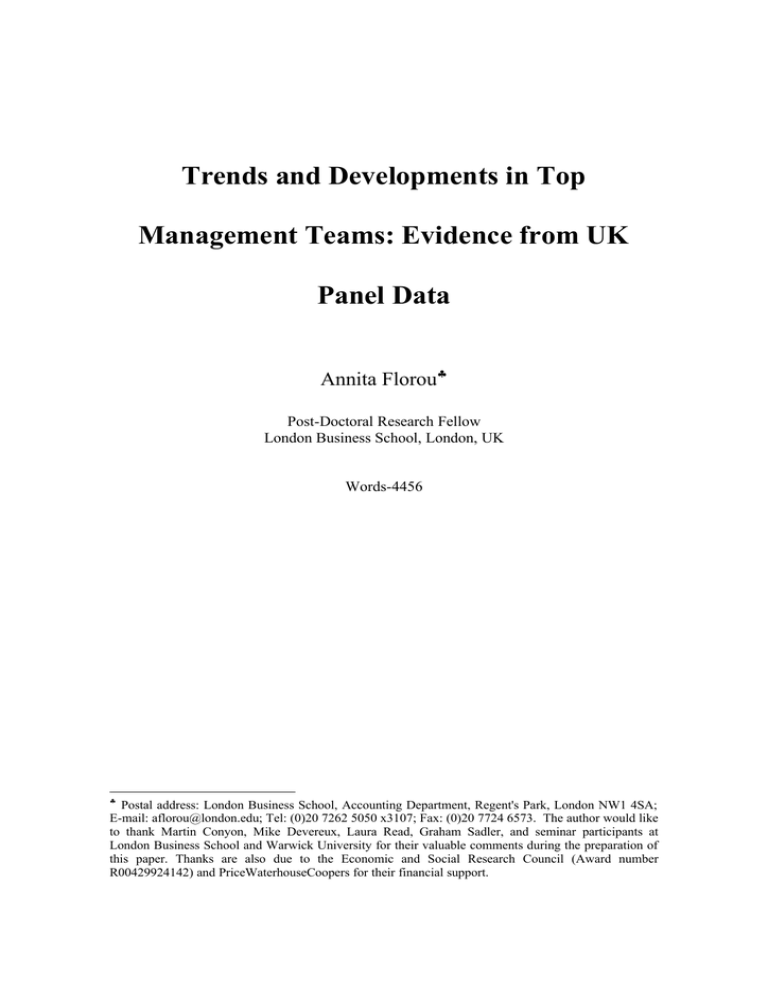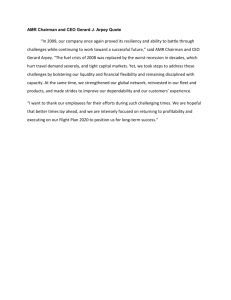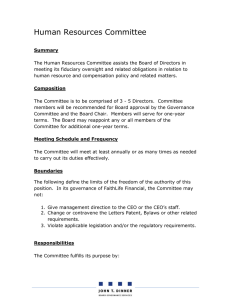Trends and Developments in Top Management Teams: Evidence from UK Panel Data

Trends and Developments in Top Management Teams: Evidence from UK Panel Data
Annita Florou
♣ Post-Doctoral Research Fellow London Business School, London, UK Words-4456 ♣ Postal address: London Business School, Accounting Department, Regent's Park, London NW1 4SA; E-mail: aflorou@london.edu; Tel: (0)20 7262 5050 x3107; Fax: (0)20 7724 6573. The author would like to thank Martin Conyon, Mike Devereux, Laura Read, Graham Sadler, and seminar participants at London Business School and Warwick University for their valuable comments during the preparation of this paper. Thanks are also due to the Economic and Social Research Council (Award number R00429924142) and PriceWaterhouseCoopers for their financial support.
Trends and Developments in Top Management Teams: Evidence from UK Panel Data
Annita Florou
Abstract
A considerable amount of research has been given to the board of directors. Little interest, however, has been shown to the top management team itself and the individual leaders. Based on a sample of the 460 largest UK listed companies during the period 1990-1998 this paper documents new evidence regarding: a) the recent developments in the structure of UK top management teams, b) the implications of joint CEO/Chair roles, and c) the profile of all senior managers and individual leaders in UK companies. It is concluded that there have been important shifts in the composition of British top management teams over the last decade, there are significant managerial differences between combined and non-combined CEO/Chair positions as well as between the individual leaders and the rest senior managers, and that there has been a fall in the use of executive stock compensation. 1
Introduction
The UK corporate governance guiding codes recognise the directors' board not only as the cornerstone of a successful corporate governance regime but also as a fundamental prerequisite for the integrity of the corporations’ accounting and financial reporting systems (e.g. Cadbury Report, 1992; the Combined Code, 1998). This public interest in turn has resulted in a number of academic papers focusing on several board issues. For example, Westphal (1998), Charan (1998) and others focus on demographic diversity in the boardroom. A considerable amount of studies concentrate on the level of women participation in the boards (e.g. Conyon and Mallin, 1997; Holton, 2000; Singh, Vinnicombe and Johnson, 2001). Several studies review annual reports or conduct questionnaire surveys in order to gain insights into the composition of the directors' board (e.g. Conyon and Mallin, 1994; Doble, 1997; Dedman, 2000a) or the board size and the level of directors' stock ownership (Dedman, 2000b, Dahya, McConnell and Travlos, 2001). In a similar vein, a relatively limited number of studies focus on different board leadership structures, i.e. separate vs. joint CEO/Chairmanships, (Dahya, Lonie and Power, 1996; Daily and Dalton, 1997; Dedman, 2000a). Existing evidence, however, regarding the implications of the above alternative leadership scenarios are conflicting. Whilst the board of directors has been the focus of a number of studies, less research attention has been given to the top management team, a division of the board with very important and distinctly different responsibilities. Moreover, even less academic interest 2
has been shown in the CEO or the individual leader. Stated otherwise, little is known about the way top management teams, instead of directors' boards, are structured (i.e. the number of CEO vs. MD positions, the number of executive vs. non-executive Chairmanships etc.) or about the profile of top managers, (i.e. age, tenure, and stock ownership), instead of that of the entire boardroom. One of the main reasons for the lack of analysis in the above areas has been the considerable difficulty of collecting the appropriate data. A rigorous investigation of the above issues requires detailed information on the identities of top managers, whereas data based on a limited number of years can be limited in its attempt to cast new light on particular time-series patterns. Moreover, as explained in the following sections, the identification of the leading executive in UK firms is a particularly complicated task. Accordingly, the analysis undertaken in this paper is among the first to utilise a rich source of panel data, representing a key contribution to the UK corporate governance literature. In particular, drawn on the top 460 UK listed companies by market capitalisation over the period 1990-1998, the contribution of the current study is three-fold. Firstly, it reports certain developments in the structure of UK top management teams over the last decade. Secondly, it yields new evidence on the controversial issue of CEO duality by investigating the extent to which different leadership structures may imply different levels of firm performance or managerial entrenchment. Finally, it documents several stylised facts regarding the profile of both all senior managers and the individual leaders in UK companies. 3
The study's main findings can be summarised as follows. Firstly, UK companies are more likely, nowadays than in the past, to adopt the "CEO" title (as opposed to the "Group Managing Director" title) in order to signal the top corporate position, to have non-executive Chairmen (as opposed to executive Chairmen), and to separate the roles of CEO/MD and Chairman. Secondly, joint CEO(MD)/Chairpersons are more likely to establish themselves within the organisation; yet, combined roles do not appear to be harmful to the company's performance. Finally, UK leading executives tend to be younger and hold a larger proportion of the firm's equity compared with the rest senior managers whereas on an aggregate level executive stock compensation (both ordinary and option holdings) has declined during the 1990-1998 period. The remainder of the paper continues as follows. The next section illustrates how the final sample of companies of the study was selected. This is followed by the description of the data collection process. Results are then presented and discussed. Finally, the study's conclusions are drawn in the last section.
The Sample
The study was based on a sample of the top 460 UK companies listed on the London stock market over the period 1990-1998. The companies were selected as follows. Using Datastream and excluding all investment trusts and the repetitions of those firms that had two classes of shares listing on the London Stock Exchange (e.g. B or Non Voting shares), the top 300 UK companies ranked by market capitalisation on 1 st January each year were included. In each of the separate years over 1990 to 1998 the largest 300 companies have, of course, changed as some companies exited the list (e.g. 4
through take-over, death or decline in capitalisation) and other firms entered. The selection procedure resulted in the main data set that consists of an unbalanced panel of 460 UK companies quoted on the London stock market over the period 1990-1998. In addition to Datastream, the Changes of Names 1965-1998 (1999) was also used to identify companies that changed their name during 1990-1998 and the London Share Price Database Reference Manual, 1997 (LSPD) to identify the first date on which the company was listed on the London Stock Exchange (birth date) and the day on which the company ceased to exist (death date) due to take-over, merger or liquidation. In these cases, top management information was not entered, for the years preceding the birth date and/or the years following the death date.
Data Assembly
As highlighted, the data collection process was particularly time-consuming and labour intensive. This section discusses the variables collected and analysed in Sections 4, 5 and 6.
Identifying Top Managers
The names and the type of position, i.e. executive or non-executive, of each company’s Chief Executive Officer (CEO), Chairman, and group Managing Director (MD) - wherever applicable - were manually recorded from the September issue of the PriceWaterhouseCoopers (PWC) Corporate Register (Companies Section). This procedure was repeated for each September edition of the PWC Corporate Register from 1990 to 1998. Information was supplemented through a number of other sources, 5
such as Annual Company Accounts (provided by LASER D) and Extel Financial UK Quoted Companies – Annual Cards. A valuable contribution of this study is the documentation of trends and developments regarding not only UK top management teams but also UK leading executives. More specifically, identifying the most senior executive in UK firms is a complicated task since the title "Chief Executive Officer" has only comparatively recently been used to signal the top corporate position. Other titles such as Chairman and Managing Director are also used - especially in earlier periods. This paper presents new evidence on the profile of the company's Most Senior Executive (hereafter denoted as MSE), who - for each year and each company - was taken to be the CEO if such a role existed. When no CEO existed the Most Senior Executive was taken to be either the Executive Chairman or the group Managing Director.
Stock Ownership
The number of ordinary and option holdings of each company’s CEO, Chairman, and Managing Director were manually recorded from the September issues of the PWC Corporate Register (Companies Section). This procedure was repeated for each edition of PWC Register from 1990 to 1998. Information on top managers' equity was supplemented through other issues of the PWC Corporate Register and Annual Company Accounts. 6
Birth Dates
The birth dates of the sample's top managers were mainly collected through three sources: a) various issues of the PWC Corporate Register (Directors’ and Officers’ Section), b) the Directory of Directors (1999), and c) the Companies House in Birmingham.
Tenure
The appointment dates of each company’s CEO, Chairman, and Managing Director at the particular position were recorded from the September Issue of PWC Corporate Register (Directors’ and Officers’ Section) for each year of the 1990-1998 period. A number of sources were used to gather the missing appointment dates. These include other PWC Corporate Register, Extel Financial UK Quoted Companies – Annual Cards, Annual Company Accounts, Financial Times Archive, and a mail survey followed up by a phone call or fax.
Company Variables
Two measures of company performance were used in this study; company stock returns and return on assets. The return on the company’s stock is calculated as the log of (RI t+1 /RI t ), where RI stands for Return Index on 1 st January 1 . The return on assets is calculated as the level of accounting earnings before interest and tax divided by the book value of the firm’s total assets in the beginning of the year. Size is measured as the log of the market value of the company. The above data was obtained from Datastream. The 3-digit and 1-digit industrial classification codes and industry description were then recorded based on the company’s entry in the PWC Corporate Register in September, 7
1995. Finally, the total number of ordinary shares in issue of each company for each year over the period 1990-1998 was manually recorded from the September issues of the PWC Corporate Register (Companies Section). Similarly to top managers' equity, information regarding the company’s share capital was supplemented through other issues of the PWC Corporate Register and company accounts.
Changes in the Structure of UK Top Management Teams
Overall, the sample consists of 1385 different top managers that were in office from 1990 to 1998. Tables 1 and 2 illustrate several developments regarding the composition of top management teams in the UK. The first one presents the total number of CEO, Chairman and group MD positions by year. The second one presents the number of executive and non-executive Chairman positions as well as the number of cases in which the company’s Chairman holds a combined role, i.e. he is also the CEO or the group Managing Director. [INSERT TABLES 1 & 2] As already highlighted, UK companies have gradually adopted the title "Chief Executive Officer" to signal the top corporate position. During the early years, alternative titles such as “Chairman” or “Managing Director” were actually more often used. The pattern that emerges from both tables confirms this argument. As shown in Table 1, the number of CEO positions has increased from 223 in 1990 to 278 in 1998 whilst the number of group Managing Director posts has decreased from 165 in 1990 to 8
78 in 1998. In contrast, Table 1 demonstrates that there is no monotonically time-series trend in the total number of Chairman positions. Nevertheless, a striking observation made from Table 2 is that the number of executive Chairmen has decreased by more than 42% over the period 1990-1998 whereas the number of non-executive Chairmen has increased by 97% during the same period. This finding reinforces the argument that as the CEO title is increasingly used to denote the company’s leading executive, there is a shift in the Chairman’s responsibilities who now becomes less involved with “steering the ship”, i.e. run the company, and more involved with “setting the tone and blowing the whistle”, i.e. run the board and monitor the CEO, (Financial Times, 2001). Table 2 illustrates that in 1990 108 UK companies (29% of the total sample) had a Chairman-CEO/MD dual position whilst in 1998 only 21 companies (6% of the total sample) kept these roles combined. Consequently, there has been approximately an 81% fall in the number of cases in which the positions of the Chairman and CEO or group Managing Director are held by a single individual. Bearing in mind that the first Code of Best Practice in corporate governance published by the Cadbury Committee in December 1992 recommended that companies separate the two roles, evidence suggest that companies seem to have complied with these proposals (although it should be noted that, as shown, the declining trend had already started taking place prior to 1992). The results can be compared with the empirical evidence of two prior studies. In the first one, Conyon (1994) employs a sample of roughly 400 UK quoted companies and 9
finds that the percentage of large quoted UK companies in which the roles of Chairman and CEO were not combined rose from 57% in 1988 to 77% in 1993. In the second one, Dahya, McConnell and Travlos (2001) report that prior to Cadbury, the Chairman of the board also held the position of top manager in 36.5% of the companies; after Cadbury, that fraction dropped to 15.4%. Finally, a striking feature of the data is that female top managers account for less than 0.7% of the total. This is consistent with a number of previous studies who also document cases of serious under-representation of women in the boardroom and in particular, cases of low incidence of female executive directors in UK firms (Conyon and Mallin, 1997; Holton, 2000; Singh, Vinnicombe and Johnson, 2001).
Joint Versus Separate CEO/Chair Roles
A topic central to the issue of corporate governance has been that of separating the roles of Chairman and CEO. Following the recommendations of the UK Cadbury Report (1992) that these roles should remain distinct and separate, a number of academic studies focused on the implications of different leadership structures. Nevertheless, existing evidence is both sparse and inconclusive. For example, Dedman (2000a) documents significant differences between combined and non-combined positions in certain variables - such as age, ownership and tenure - suggesting that joint CEO/Chairpersons are more likely to entrench themselves. She does not find any evidence, however, that this is detrimental to firm performance. On the other hand, Daily and Dalton (1997) report that separate Chairpersons have actually 10
more tenure as CEO and hold a larger percentage of the firm's equity compared with their joint CEO/Chairperson counterparts whereas Dahya et al. (1996) find that following the adoption of a dual CEO position, the accounting performance of companies appears to decline. Table 3 provides additional evidence on the controversial issue of CEO duality. More specifically, it documents certain differences in both managerial and firm characteristics between those CEOs/MDs who are also Chairmen and their counterparts who do not hold combined roles. [INSERT TABLE 3] As illustrated, joint CEO(MD)/Chairman executives are significantly older, stay longer in office, and own a larger fraction of the company's equity (but not a larger proportion of option holdings); the p-value of the t statistic for the difference in the averages of all the above variables is 0.000. Furthermore, the data indicate that smaller companies are more likely to keep the roles combined whereas firm performance - both stock-based and accounting-based - does not seem to be significantly different between the two groups. Overall, evidence suggests that joint CEO(MD)/Chairmen may be associated with different levels of managerial entrenchment but not with different levels of firm performance. 11
The Profile of UK Top Management Teams
The analysis finishes with the discussion of several stylised facts regarding the profile of top management teams in UK companies. In particular, Tables 4, 5 and 6 report descriptive information on three main managerial attributes: a) age, b) organisational tenure, and c) stock-based compensation. Stock-based compensation provides a direct link between shareholder wealth and CEO wealth, because each pound increase in the stock price increases the value of ordinary shares, stock options etc. Accordingly, it is widely argued by agency scholars that stock-based compensation can provide financial incentives for managers to take actions that increase shareholder wealth, and to avoid actions that decrease shareholder wealth (Jensen and Murphy, 1990; Murphy, 1999; Conyon and Murphy, 2000a). Table 4 shows that the leading executive of a UK company (i.e. Most Senior Executive) has both higher ordinary and option holdings than the rest top executives (2.37% and 0.24% as opposed to 1.55% and 0% respectively). Bearing in mind that organisational theorists (e.g. Glover, 1976; Hofer, 1980; Steiner, Miner and Gray, 1982) have largely agreed that CEOs are the principal individuals responsible for the company’s economic status, the above finding is in line with the argument of tying CEO compensation to stock price. Moreover, as indicated the leading executives in UK companies are also younger compared to the rest top managers. The average age of a leading executive is approximately 53 whilst non-Most Senior Executives are about 58 years old; the p value of the t-statistic for the difference in mean stock-based compensation and age of MSE 12
and non-MSE is 0.00, indicating its statistical significance. Finally, data reveal that on average both the Most Senior Executives and the rest non-MSE executives serve in office for about 5 years. [INSERT TABLE 4] The analysis of managerial stock compensation is continued in Table 5, which presents time-series data on the fraction of both ordinary and option holdings of the leading executives. As reported, ordinary MSE holdings (as a % of common equity) have declined from 3.25% in 1990 to 1.20% in 1998. The fraction of option holdings owned by the company leading executive in 1994 was two times as much as that in 1990 whilst in 1998 it fell by 26% (when compared with 1994). This evidence is consistent with the findings of Main (1999) who - based on data provided by a large compensation consulting firm - demonstrates that the prevalence of option schemes in the UK grew dramatically from the mid-1980s to the early 1990s to fall again in the mid-1990s. In particular, in 1978 only 10% of UK companies offered options to their top executives, by 1983 over 30% of companies had established option schemes, and by 1986 this figure had increased to almost 100%. However, the use of share options in the UK fell substantially in the mid-1990s whilst by 1997 only 68% of companies were in a position to offer options to their top executives. [INSERT TABLE 5] 13
Finally, Table 6 depicts the fraction of stock-based compensation, the age and the tenure of all UK senior managers by industry sector. Two very interesting observations are derived from this table. Firstly, the utilities sector has the oldest top managers with the least tenure in office and the lowest fraction of stock-based compensation (both ordinary and option holdings). The latter finding is consistent with that of Conyon and Murphy (2000b) who, based on a sample of the largest UK companies in 1997, report that the proportion of share holdings and option holdings (as a % of common equity) for utilities is 0.01% and 0.03% respectively and the lowest compared with the rest industry sectors. Taken together, this evidence confirm Smith and Watts (1982) who argue that stock based compensation is predicted to be less prevalent in regulated industries (i.e. industries where it is more difficult to alter the risk of investment). Secondly, general manufacturers have the highest top managerial option holdings and the second highest top managerial ordinary holding (0.20% and 2.11% respectively). This in turn, is in line with a stream of literature, which reports that high-growth firms (e.g. chemicals, electrical equipment etc.) have a significantly higher incidence of stock based compensation and in particular, of stock option plans (Smith and Watts, 1992; Gaver and Gaver, 1993; Collins, Blackwell and Sinkey, 1995; and Baber, Janakiraman, Kang, 1996). [INSERT TABLE 6] 14
Concluding Remarks
While too much weight has been placed on boards of directors, very little attention has been drawn to the top management team, a group with unique and distinctly different roles from the rest company directors. Using data from the top 460 UK companies by market capitalisation over a nine-year period (i.e. 1990-1998) the aim of this paper has been to gain valuable insights into: a) the structure of UK top management teams, b) the implications of CEO duality, and c) the profile of both all senior managers and the individual leaders of British companies. This paper has added to the UK corporate governance literature in the following three ways. Firstly, results indicate that over the last nine years there have been significant changes in the structure of UK top management teams, which tend to consist of more CEO titles, less executive Chairmen and less combined roles. Secondly, it appears that joint CEO/Chairpersons have an increased propensity to entrench themselves whilst there is not strong evidence suggesting different levels of firm performance under alternative leadership structures. Finally, it was documented that the individual leaders (MSEs) tend to be younger and owners of a larger fraction of the firm's equity than the rest senior managers; nevertheless, the use of MSE managerial stock compensation has declined during the last decade. 15
Table 1
Chairman, CEO and Group MD Positions by Year, Time-Period: 1990-1998, Sample: Top 460 London Stock Exchange Firms
Year
1990 1991 1992 1993 1994 1995 1996 1997 1998
Total Chairmen
374 386 386 390 390 394 387 380 362
3449 CEOs
223 223 240 256 270 281 282 284 278
2337 Group MDs
165 177 161 130 124 114 101 84 78
1134
16
Table 2
Executive Chairmen, Non-Executive Chairmen and Combined Roles by Year, Time Period: 1990-1998, Sample: Top 460 London Stock Exchange Firms
Year
1990 1991 1992 1993 1994 1995 1996 1997 1998
Total Executive Chairmen
269 280 253 240 214 205 176 173 155
1965 Non Executive Chairmen
105 106 133 150 176 189 211 207 207
1484 Combined Roles
108 96 82 62 47 36 33 30 21
515
17
Table 3
Characteristics of Dual CEO(MD)/Chairman Positions Versus Non-Dual Positions, Time-Period: 1990-1998, Sample: Top 460 London Stock Exchange Firms
Average
Ordinary Holdings (% of Common) Option Holdings (% of Common) Age Tenure as CEO/MD Stock Returns Return on Assets Size (log of market value)
Dual
5.16% 0.16% 56.1 9.84 0.038 0.114 6.32
Non-Dual
0.57% 0.26% 51.1 3.43 0.067 0.114 6.57
p-value
0.000 0.209 0.000 0.000 0.135 0.959 0.000 18
Table 4
MSE and Non-MSE Stock-Based Compensation, Age and Tenure, Time-Period: 1990 1998, Sample: Top 460 London Stock Exchange Firms
Average
Ordinary Holdings (% of Common) Option Holdings (% of Common) Age Tenure
MSE
2.37% 0.24% 53.6 5.42
Non-MSE
1.55% 0.00% 57.9 5.37
p-value
0.000 0.000 0.000 0.758 19
Table 5
Most Senior Executive Stock-Based Compensation by Year, Time-Period: 1990-1998, Sample: Top 460 London Stock Exchange Firms
Year
1990 1991 1992 1993 1994 1995 1996 1997 1998
Ordinary Holdings (% of Common)
3.25% 3.15% 2.74% 2.43% 2.38% 2.00% 2.37% 1.77% 1.20%
Option Holdings (% of Common)
0.16% 0.16% 0.19% 0.30% 0.34% 0.19% 0.40% 0.21% 0.25% 20
Table 6
Top Management Stock-Based Compensation, Age and Tenure by Industry Sector, Time-Period: 1990-1998, Sample: Top 460 London Stock Exchange Firms
Industry Sector
Mineral Extraction General Manufacturers Consumer Goods Services Utilities Financials
Ordinary Holdings (% of Common)
1.19% 2.11% 1.80% 2.84% 0.20% 1.14%
Option Holdings (% of Common)
0.12% 0.20% 0.17% 0.16% 0.00% 0.18%
Age
54.9 56.3 55.2 55.2 56.8 56.0
Tenure
4.05 5.80 4.48 5.89 2.83 6.07 21
NOTE
1 A company’s return index shows the growth in the share value and the value of the dividends. The relevant formula is: RI t = RI t-1 * (P t +D t )/P t-1 , where P t = price on ex-date (i.e. the day dividend payments become certain), P t-1 = price on previous day and D t = dividend payment associated with ex-date t. 22
REFERENCES
Baber, W.R. Janakiraman, S.N. and Kang, S. (1996) Investment Opportunities and the Structure of Executive Compensation, Journal of Accounting and Economics, 21, 297-318. Cadbury, D. (1992) Committee on Financial Aspects of Corporate Governance: Final Report, Gee Publishing, London. Charan, R. (1998) Boards at Work: How Corporate Boards Create Competitive Advantage, Jossey-Bass, San Fransisco. Collins, M. Blackwell, D. and Sinkey, J. (1995) The Relationship between Corporate Compensation Policies and Investment Opportunities: Empirical Evidence for Large Bank Holding Companies, Financial Management, 24 (3), 40-53. Conyon, M. (1994) Corporate Governance Changes in UK Companies Between 1988 and 1993, Corporate Governance: An International Review, 4 (2), p. 87. Conyon, M. and Mallin, C. (1994) A Review of Compliance with Cadbury, Journal of General Management, 22 (3), 24-37. Conyon, M. and Mallin, C. (1997) Women in the Boardroom: Evidence from Large UK Companies, Corporate Governance: An International Review, 5 (3), 112-117. Conyon, M.J. and Murphy, K.J. (2000a) The Prince and the Pauper? CEO Pay in the United States and the United Kingdom, Economic Journal, 110 (467), 640-671. Conyon, M.J. and Murphy, K.J. (2000b) Stock-Based Executive Compensation, Working Paper, University of Pennsylvania. Daily, C.M. and Dalton, D.R. (1997) Separate, but not Independent: Board Leadership Structure in Large Corporations, Corporate Governance: An International Review,5 (3), 126-136. Dahya, J. Lonie, A.A. and Power, D.M. (1996) The Case for Separating the Roles of Chairman and CEO: An Analysis of Stock Market and Accounting Data, Corporate Governance: An International Review, 4 (2), 71-77. Dahya, J. McConnell, J.J. and Travlos, N.G. (2001) The Cadbury Committee, Corporate Performance and Top Management Turnover, Journal of Finance, forthcoming. Dedman, E. (2000a) An Investigation into the Determinants of UK Board Structure Before and After Cadbury, Corporate Governance: An International Review, 8 (2), 133-153. Dedman, E. (2000b) Executive Turnover in UK Firms: The Impact of Cadbury, Working Paper, University of Bristol. Doble, M. (1997) The Impact of the Cadbury Code on Selection of Directors and Board Composition in UK Newly-Quoted Companies, 1990-1994, Corporate Governance: An International Review, 5 (4), 214-223. Financial Times, (February 2001) In the Director's Chair, FT Partnership Publications, London. Gaver, J.J. and Gaver, K.M. (1993) Additional Evidence on the Association between the Investment Opportunity Set and Corporate Financing, Dividend, and Compensation Policies, Journal of Accounting and Economics, 16, 82-97. Glover, J.D. (1976) The Many Roles of the Chief Executive. In J.D. Glover and G.A. Simon (Eds.), Chief Executive Handbook, pp. 3-21, Ill: Dow Jones-Irwin, Homewood. Hofer, C.W. (1980) Turnaround Strategies: An Examination, Journal of Business Administration, 1, 19-31. 23
Holton, V.M. (2000) Taking a Seat on the Board: Women Directors in Britain. In R.J. Burke and M. Mattis (Eds.) Women in Corporate Boards of Directors: International Challenges and Opportunities, pp. 145-156, Kluwer Academic Publishers, Dordrecht, The Netherlands. Jensen, M.C. and Murphy, K. (1990) Performance Pay and Top-Management Incentives, Journal of Political Economy, 98 (2), 225-264. London Stock Exchange (1998), The Combined Code of the Committee on Corporate Governance, London Stock Exchange, London. Main, B.G. (1999) The Rise and Fall of Executive Share Options in Britain. In J. Carpenter and D. Yermack (Eds.), Executive Compensation and Shareholder Value: Theory and Evidence, pp. 83-113, Kluwer Academic Press, Dordrecht. Murphy, K.J. (1999) Executive Compensation. In O. Ashenfelter and D. Card (Eds.) Handbook of Labour Economics, Vol. 3, North Holland. Singh, V. Vinnicombe, S. and Johnson, P. (2001) Women Directors on Top UK Boards, Corporate Governance: An International Review, 9 (3), 206-216. Smith, C.W. and Watts, R. (1982) Incentive and Tax Effects of US Executive Compensation Plans, Australian Journal of Management, 7, 139-157. Smith, C.W. and Watts, R. (1992) The Investment Opportunity Set and Corporate Financing, Dividend, and Compensation Policies, Journal of Financial Economics, 32 (3), 263-292. Steiner, G.A. Miner, J.B. and Gray, E.R. (1982) Management Policy and Strategy, Macmillan Book Publishing Co, New York. Westphal, J. (1998) Board Games: How CEOs Adapt to Increases in Structural Board Independence from Management, Administrative Science Quarterly, 43, 511 537. 24
25







